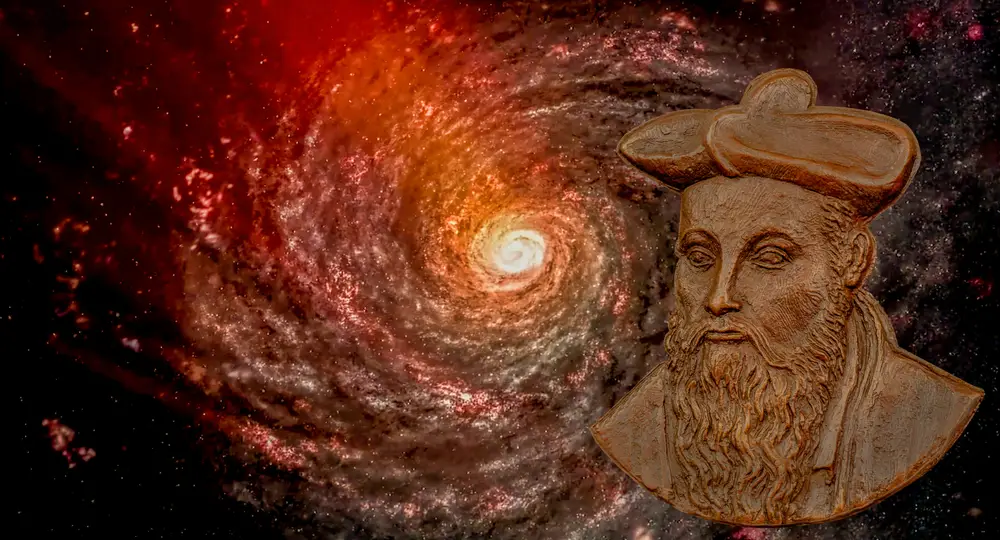As we stand on the cusp of the year 2024, the enigmatic and often eerie prophecies of Michel de Nostredame, or Nostradamus, continue to capture the collective imagination and send shivers down the spines of people worldwide. Nostradamus, a French astrologer and reputed seer of the 16th century, is best known for his prophetic verses in a work called “Les Propheties.” His cryptic and often perplexing predictions have, over the centuries, fueled speculation, intrigue, and fear. In this article, we embark on a journey into the depths of Nostradamus’ predictions for the year 2024, exploring the themes of climate chaos, geopolitical tensions, royal turmoil, and potential controversies within the papacy.
Climate Chaos: A Dire Situation Unfolds
Nostradamus’ prophetic verses, often shrouded in cryptic language, cast a foreboding shadow over the state of the world’s climate in the year 2024. His poetic vision, composed in quatrains, hints at a grim and apocalyptic scenario that leaves readers contemplating the fate of our planet.

Drought and Deluge: Nature’s Wrath Unleashed
Within the depths of Nostradamus’ verses, we find a world increasingly besieged by the relentless forces of nature. Two elements, drought, and devastating floods, stand out as the harbingers of ecological catastrophe. The mere mention of these catastrophic climatic events is enough to send a chill down the spine of anyone who contemplates their implications.
The threat of severe droughts in certain regions looms ominously in Nostradamus’ predictions. These droughts, if they come to pass, have the potential to disrupt fragile ecosystems and throw agricultural productivity into disarray. Crop failures, water scarcity, and food resource depletion could become the new norm in the affected areas. Such dire consequences would undoubtedly have ripple effects across the globe, impacting food prices, exacerbating hunger, and straining international relations.
Pestiferous Waves and the Specter of Tsunamis
Yet, it is the cryptic mention of a “very great famine through pestiferous wave” that stands out as a particularly unsettling aspect of Nostradamus’ vision. The words “pestiferous wave” evoke images of more than just typical floods; they conjure up visions of cataclysmic tsunamis that could devastate coastlines and low-lying areas. These tsunamis would not only wreak havoc on infrastructure but also destroy vital agricultural lands, rendering them unproductive for years to come.
The aftermath of such pestiferous waves would extend far beyond immediate destruction. They could facilitate the rapid spread of diseases, as stagnant water and decaying organic matter become breeding grounds for pathogens. The resulting public health crises could strain healthcare systems to the breaking point, further compounding the misery inflicted by the climatic cataclysms.
Widespread Starvation: The Grim Consequence
The ultimate consequence of this combination of factors, droughts, floods, tsunamis, and disease, is a bleak one—widespread starvation. Nostradamus’ ominous prediction seems to suggest that the year 2024 may witness humanity facing a level of hunger and suffering unparalleled in recent history. The scarcity of food resources, contaminated water supplies, and disrupted supply chains could lead to famine on a global scale.
This grim prospect should serve as a profound wake-up call for humanity. It underscores the urgent need for action to mitigate the effects of climate change, protect vulnerable regions, and ensure food security for all. Nostradamus’ cryptic verses may serve as a stark warning, but they also offer an opportunity for us to recognize the critical importance of sustainable practices and responsible environmental stewardship.
Geopolitical Tensions: China’s Naval Power and Global Implications
Nostradamus’ prophetic verses do not confine themselves solely to environmental concerns; they also pierce the veil of international politics, offering glimpses of a world teetering on the brink of geopolitical upheaval. In this section, we delve into the intricacies of Nostradamus’ predictions concerning China’s naval power and the profound global implications that may follow.

The Naval Battle: A Confrontation Unfolds
Nostradamus’ enigmatic quatrains present a tantalizing scenario involving a “naval battle.” This cryptic reference raises questions about which nations or entities may be embroiled in this high-stakes confrontation. The mention of the “Red adversary” becoming “pale with fear” suggests a pivotal role for China, often referred to as the “Red Dragon” in historical and symbolic contexts. This foreboding imagery conjures images of a nation, once confident and assertive, now facing a crisis that leaves it trembling with trepidation.
The “great Ocean in dread” alluded to by Nostradamus underscores the global nature of this potential conflict. The vast expanse of the world’s oceans serves as a conduit for international trade, communication, and transportation. Any disruption to the free flow of maritime traffic has far-reaching consequences, affecting economies, security, and diplomatic relations worldwide.
Rising Tensions and China’s Naval Ascendancy
One cannot ignore the backdrop against which Nostradamus’ prophecy is set. In recent years, China has steadily expanded its naval power, modernizing its fleet and asserting its presence in the South China Sea, a region rife with territorial disputes. This ascent has not gone unnoticed by the international community, leading to heightened tensions and concerns about the potential for conflict.
The potential clash at sea, as hinted by Nostradamus, underscores the delicate balance of power in the contemporary world. As China continues to exert its influence in the Asia-Pacific region, it finds itself in a complex dance with established superpowers such as the United States. The rivalry between these global giants poses not only regional but also global implications.
Nostradamus’ prophecy serves as a stark reminder of the imperative need for diplomatic resolutions to prevent catastrophic confrontations. The intricate web of international relations, trade agreements, and alliances means that any major conflict could have cascading effects, destabilizing the world order. The cost of such a confrontation in human lives, economic turmoil, and political repercussions is too great to contemplate.
Global Implications: A World on Edge
The potential ramifications of a naval battle involving a superpower like China extend far beyond the parties directly involved. The ripple effects would be felt across the globe, affecting nations large and small. The disruption of vital trade routes, energy supplies, and global markets could trigger economic turmoil on a scale not seen in decades.
Moreover, the specter of a major conflict carries the risk of military escalation, potentially drawing in other nations through alliances and mutual defense agreements. The consequences of such a scenario are dire, with the potential for loss of life and widespread destruction.
Monarchy Turmoil: A King’s Reckoning and the Unpredictability Ahead
Nostradamus’ prophetic insights extend beyond matters of climate and geopolitics; they also peer into the intricate tapestry of royalty, casting an enigmatic shadow over the world of monarchy in 2024. In this section, we unravel the cryptic verses that hint at a turbulent path within a royal family, the removal of a “King of the Isles,” and the rise of an unconventional successor.

The Cryptic Transition: From King to the Unknown
Within the depths of Nostradamus’ verses, the fate of a monarchy is foretold, one marked by uncertainty and upheaval. The cryptic reference to the “King of the Isles” hints at a monarch who reigns over a realm known for its rich history and tradition. Yet, the prophecy takes a dark turn, suggesting that this royal figure will be forcibly removed from the throne.
Speculation runs rife as to the identity of this monarch, with many contemplating whether it may allude to King Charles III, the heir to the British throne. The prediction implies that he may face an intense crucible of public scrutiny and pressure, potentially culminating in his abdication. Such an event would be a seismic shift in the course of British history, a momentous transition from one era to another.
An Unconventional Figure’s Ascent
What follows in Nostradamus’ prophecy is equally intriguing—an ascent to the throne by an individual “who will have no mark of a king.” The enigmatic nature of this description leaves room for interpretation and raises questions about the identity and qualities of this successor. Is this an allusion to Prince Harry, who, by traditional standards, may be considered an unconventional figure for the royal role?
Prince Harry’s reputation for being unorthodox, outspoken, and willing to challenge traditional norms certainly fits the bill. His choices, from stepping back from royal duties to advocating for mental health awareness and environmental causes, have set him apart from the conventional royal path. Nostradamus’ prophecy introduces an element of unpredictability and intrigue into the future of the monarchy, with the potential for unconventional leadership challenging established norms.
Monarchy in the Modern World: Evolving Expectations
Nostradamus’ predictions for the monarchy in 2024 invite contemplation on the dynamics of monarchy in the modern world. The institution of royalty, once characterized by tradition, protocol, and continuity, finds itself grappling with evolving expectations, public scrutiny, and the demands of contemporary society.
The turbulent path forecasted by Nostradamus raises poignant questions about the role of tradition in contemporary society. Will the British monarchy adapt to the changing values and expectations of its subjects, or will it continue to be bound by centuries-old customs and norms? The monarchy’s response to these challenges will have profound implications for its enduring relevance and the support it garners from the British public.
The Broader Implications: A Royal Odyssey
Beyond the confines of Britain’s palaces and courts, Nostradamus’ predictions about the monarchy in 2024 reverberate on a global scale. The British monarchy, with its rich history and cultural significance, is a source of fascination and intrigue for people worldwide. Any major shifts or crises within the royal family have the potential to capture international attention and shape perceptions of monarchy in general.
As the world watches the royal drama unfold, it prompts broader questions about the role of monarchy in the 21st century. How do monarchies reconcile their historical legacies with the realities of the modern world? Can they remain relevant and influential in a rapidly changing global landscape? Nostradamus’ prophecy offers a tantalizing glimpse into a royal odyssey fraught with challenges and uncertainties, and its resolution will undoubtedly have far-reaching implications.
Papal Controversies: A Changing Pontiff Raises Questions
Nostradamus’ prophetic visions extend their gaze to the very heart of the Vatican, offering glimpses into the future of the Catholic Church in the year 2024. In this section, we delve into the cryptic verses that hint at the replacement of the current Pope, Pope Francis, due to his advanced age and the emergence of a younger Roman Pontiff. However, this seemingly hopeful transition takes a foreboding twist as Nostradamus suggests that the new Pope may “weaken his see” and hold an extended tenure, thereby raising questions about the future of the Church.

A Papal Transition: Hope and Uncertainty
Nostradamus’ prophecy initiates with the prospect of a papal transition brought about by Pope Francis’s advanced age. This anticipated change in leadership is met with mixed emotions within the Catholic Church. On the one hand, there is hope for a revitalized Church under the guidance of a younger and presumably more dynamic Pontiff. This fresh start could bring renewed vigor, inspire the faithful, and potentially address some of the challenges facing the Church in the modern world.
On the other hand, the mere notion of a papal succession carries with it a sense of uncertainty. The transition of leadership in the Vatican is a profound and historically significant event, marked by intricate rituals, centuries-old traditions, and the weight of spiritual authority. Nostradamus’ prophecy hints at a pivotal moment for the Church, one that could have far-reaching consequences.
“Weakening” the See: A Troubling Prospect
It is the enigmatic assertion that the new Pope will “weaken his see” that casts a shadow of doubt and raises troubling questions about the Church’s future. The term “weakening” suggests a decline in the influence, integrity, or authority of the Church under the new Pope’s leadership. This interpretation introduces an element of foreboding, as it implies that the Catholic Church may grapple with internal challenges or external pressures that erode its spiritual and moral authority.
The precise nature of this weakening remains a matter of speculation, and Nostradamus’ verses offer little clarity on the specifics. It could encompass a range of possibilities, from controversies within the Church to external forces that test the Church’s resolve and resilience. Whatever the case, it highlights the vulnerabilities that even a centuries-old institution like the Catholic Church may face in an ever-changing world.
Scandals and Controversies: A Dark Cloud Looms
Nostradamus’ prophecy, by alluding to the weakening of the papal see, inadvertently opens the door to speculation about potential scandals or controversies within the Vatican during this period. Scandals and controversies have, at times, rocked the foundations of the Catholic Church, leading to crises of faith and challenges to its moral authority.
While the prophecy does not provide concrete details, it underscores the fragility of institutions and the need for vigilance in safeguarding the Church’s spiritual and moral legacy. The possibility of internal strife or external pressures triggering such controversies serves as a stark reminder of the challenges that the Catholic Church may confront in 2024.
Conclusion
As we delve deeper into Nostradamus’ predictions for the year 2024, we encounter a tapestry of grim possibilities: climate chaos, geopolitical tensions, monarchy turmoil, and papal controversies. However, it is crucial to approach these prophecies with a healthy dose of skepticism. Nostradamus’ verses have remained enigmatic and open to interpretation over the centuries, offering fertile ground for speculation and debate.
While these predictions serve as a tantalizing mystery, they should also remind us of the unpredictable nature of our world. History has shown that unforeseen events and human actions often shape the course of events more significantly than any prophecy. As we stand on the threshold of 2024, let us keep a watchful eye on these predictions, but let us also remember that our collective actions, choices, and efforts have the power to determine the course of our future. Nostradamus may have offered glimpses into what could come to pass, but it is ultimately up to us to shape the destiny of our world.
Sources:
Mention of these catastrophic climatic events is enough to send a chill down the spine.
Global markets could trigger economic turmoil on a scale not seen in decades.
Such an event would be a seismic shift in the course of British history.
The challenges facing the Church in the modern world.

This Site Was Inspired By An Interest in Protecting the Environment:
We had the privilege and joy of learning from Dr. Charlie Stine who instilled a love for the natural world through incredible field trips with the Johns Hopkins Odyssey Certificate program in Environmental Studies. At the time, the program was endorsed by the Maryland Department of Natural Resources. Sadly, after Dr. Stine retired, the program was phased out. We hope that we honor his legacy by shining a bright light on environmental issues and sharing good news about the success of various conservation programs when possible.
